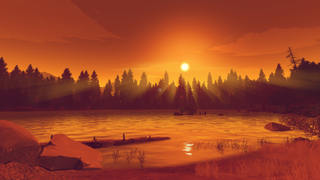
If you believe in the idea of games as vacation destinations from the real world, then they don’t come more idyllic than the Wyoming wilderness which provides the backdrop for Campo Santo’s first-person mystery Firewatch. If you haven’t spent time walking the tinder dry countryside, melancholically working out your personal issues while chatting to the disembodied but peppy voice of Delilah, then I strongly recommend doing so.
Today at GDC, artist Jane Ng presented a talk on how that world was made. Whilst mostly aimed at developers seeking to get the most out of the Unity engine, I found the talk on how the game’s trees came to be fascinating. Ng noted that she didn’t get on well with automated tree making tools, so created the 23 different models in the game by hand. There are around 4,600 different tree placements in total, not counting the flat “billboards” which appear in the far distance, and generally speaking trees take up half the screen for most of your playtime.
So why not make more types of trees? “Artists like to make art,” said Ng, “but if you can get away with 23 trees, don’t make 25.” She also explained that the best way to fill a game like Firewatch with foliage is by copy and pasting extensively. “That’s kind of my philosophy actually,” she said. “Just make a few really good modules and then instance the crap out of them.” As for the look of the trees, Ng said that Olly Moss, who worked on the art direction, 2D design and story of the game, asked for a custom shader so that the trees looked more stylised and simplified, almost like graphic art, the further away the player is from them.
Ng also explained how the trees used three main types of animation—vertical sway, branch flap, and leaf flutter—to create a sense of life, whether moved by a gentle breeze or more dramatic winds. Cool stuff, and I’d say it’s worth firing up Firewatch again just to take another look at those noble pines, swaying unbroken in the fading sun. Hang on, I think I’ve got a speck of dust in my eye...
The biggest gaming news, reviews and hardware deals
Keep up to date with the most important stories and the best deals, as picked by the PC Gamer team.
With over two decades covering videogames, Tim has been there from the beginning. In his case, that meant playing Elite in 'co-op' on a BBC Micro (one player uses the movement keys, the other shoots) until his parents finally caved and bought an Amstrad CPC 6128. These days, when not steering the good ship PC Gamer, Tim spends his time complaining that all Priest mains in Hearthstone are degenerates and raiding in Destiny 2. He's almost certainly doing one of these right now.
Most Popular







